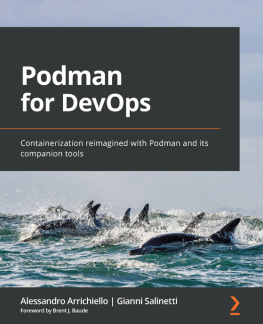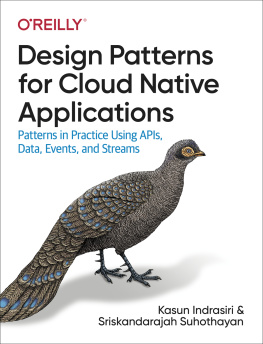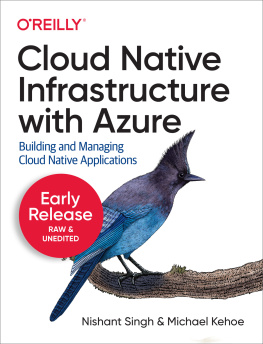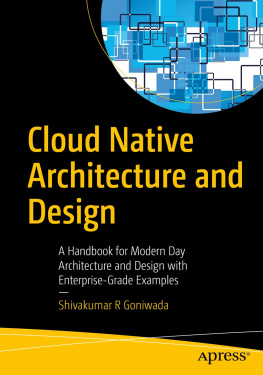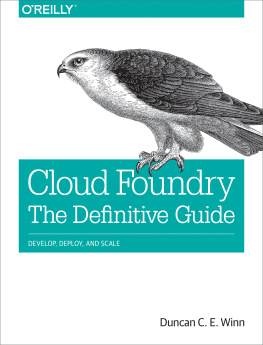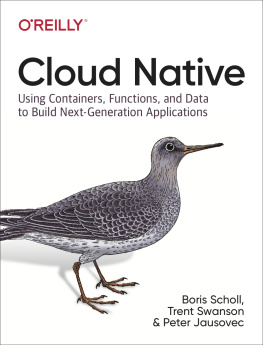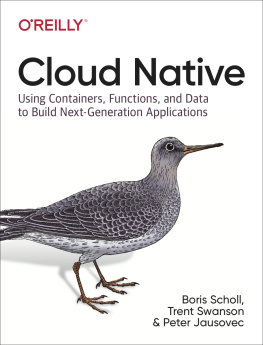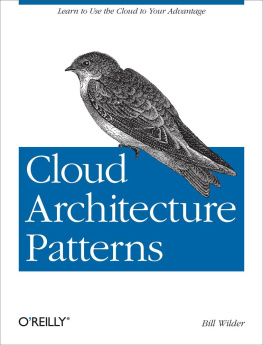Praise for Cloud Native Transformation
Cloud native is the latest checkpoint in software development that abstracts away entire data centers while encoding best practices into platforms such as Kubernetes. Unfortunately, rubbing some Kubernetes on neglected software and an undisciplined engineering philosophyisnt going to solve your problems. The ability to leverage this technology shift requires a cultural one as well.
Kelsey Hightower, Developer advocate, Google Cloud
The patterns provide invaluable information on how to think about cloud native development the right wayand valuable context for understanding why there is more than technology to a cloud native transformation.
Kyle Brown, IBM Fellow and CTO, IBM Cloud Architecture; Pattern Languages of Programs 2018 Program Chair
Pini, Jamie, and Michelle have been some of the earliest and most insightful advocates for Cloud Native architectures. Their engagement from the earliest days of the Cloud Native Computing Foundation was enormously helpful for the growth and adoption of cloud native in Europe and around the world. This book is a great opportunity to leverage their expertise .
Dan Kohn, Executive Director, Cloud Native Computing Foundation
I havent seen storytelling paired with such an extensive and detailed pattern library before. Its a really compelling combination, doing a terrific job of illustrating the patterns themselves and showing how they fit together. Its also a lot of fun to read.
Adrian Cockcroft, Cloud architect and engineer
This book is a storehouse of practical knowledge about how to achieve a cloud native transformation. From high-level strategic considerations and leadership issues down to the details of testing, integration, and delivery approaches, every choice is presented as a patterndetailed as to its advantages and disadvantages, the relevant contextual issues, and its place in the bigger picture alongside the other patterns described. Helping you put this knowledge together to address the needs of your own organization are carefully considered case studies as well as a wealth of strategic, management, and psychological insight to help you assemble the elements youll need to get to your goal and alert you to the pitfalls along the way. Essential reading for anyone looking to embark on a cloud native transformation.
Andy Wilson, Director of Technical Culture, Oliver Wyman Digital
Cloud Native Transformation
by Pini Reznik, Jamie Dobson, and Michelle Gienow
Copyright 2020 Pini Reznik, Jamie Dobson, and Michelle Gienow. All rights reserved.
Printed in the United States of America.
Published by OReilly Media, Inc. , 1005 Gravenstein Highway North, Sebastopol, CA 95472.
OReilly books may be purchased for educational, business, or sales promotional use. Online editions are also available for most titles (http://oreilly.com). For more information, contact our corporate/institutional sales department: 800-998-9938 or corporate@oreilly.com .
- Editors: Michele Cronin and Chris Guzikowski
- Production Editor: Nan Barber
- Copyeditor: Jasmine Kwytin
- Proofreader: Kim Wimpsett
- Indexer: Judy McConville
- Interior Designer: David Futato
- Cover Designer: Karen Montgomery
- Illustrator: Rebecca Demarest
- November 2019: First Edition
Revision History for the First Edition
- 2019-12-03: First Release
See http://oreilly.com/catalog/errata.csp?isbn=9781492048909 for release details.
The OReilly logo is a registered trademark of OReilly Media, Inc. Cloud Native Transformation, the cover image, and related trade dress are trademarks of OReilly Media, Inc.
The views expressed in this work are those of the authors, and do not represent the publishers views. While the publisher and the authors have used good faith efforts to ensure that the information and instructions contained in this work are accurate, the publisher and the authors disclaim all responsibility for errors or omissions, including without limitation responsibility for damages resulting from the use of or reliance on this work. Use of the information and instructions contained in this work is at your own risk. If any code samples or other technology this work contains or describes is subject to open source licenses or the intellectual property rights of others, it is your responsibility to ensure that your use thereof complies with such licenses and/or rights.
978-1-492-04890-9
[LSI]
Foreword
A few years ago, I was in Amsterdam for Dockercon Europe and met a very enthusiastic British guy with a northern accent, Jamie Dobson. He seemed to be running a company in Holland, but it wasnt at all clear what they did. A bit later that company became Container Solutions and expanded to London, and I kept running into Jamie, Pini Reznik, and Adrian Mouat (and eventually Anne Currie) at other conferences. Then the Container Solutions crew came up with this crazy idea to run a conference in a dockside warehouse in Amsterdam, one that mixed software with a kind of Burning Man vibe. It was called Software Circus.
Outside there was a 30-foot-tall fire-breathing robot called Kevin and a whole pig roasted on a spit for lunch. I was the opening keynote speaker, although I had no idea who would come and what they would want to hear about. Over 400 people turned up, and I improvised the talk with no slides, told stories, got suggestions from the audience, and the projected Twitter feed became an effective crowdsourced substitute for a presentation. Afterward, Kelsey Hightower, who was giving the keynote on the second day, told me he hadnt ever previously thought of doing a talk with no slides, but he was now inspired to have a go. Kelsey then famously gave an entire talk on container scheduling while displaying himself playing Tetris. It was one of the more memorable conferences Ive attended, but there were no videos of the talks; you had to have been there!
The people at Container Solutions think differently, dont play it safe, and seem to have a lot of fun along the way. Theyve worked on some very interesting projects over the years, and this is an unusual book; its a collection of stories and a pattern library. The stories are entertaining and illustrate the same common patterns Ive seen around the world, as companies struggle to adopt DevOps, product-based teams, microservices, continuous delivery, containers, and serverless. The pattern library is best approached as a cross-indexed random access collection. You could do a linear full table scan by reading it through, but its better to pick an interesting starting point and walk the graph by following the cross-references to related patterns. The individual patterns contain a lot of great detailed advice and arent afraid to be opinionated. I agree with most of the opinions and find that they reflect the real-world experience that is often written out of books that play it safe with generic answers.
From my experience Id like to provide three core ideas that this book illustrates in detail. First, most of the customers I meet think they have a technology adoption problem, when in reality they have an org-chart problem. The most successful orgs are made up of many small independent business teams communicating via clear APIs. If thats your org chart, you will inevitably build a microservices architecture, a trick known as the Reverse Conway Maneuver.
Second, the single most important metric for executives to focus on is time-to-value, which can be instrumented most easily as committing to deploy latency for each team. Many companies cant innovate because they cant get out of their own way, and short time-to-value (target less than a day) releases pent-up innovation from your teams. Third, there is far too much time spent in analysis paralysis, discussing technology variations and arguing about how best to architect solutions.


